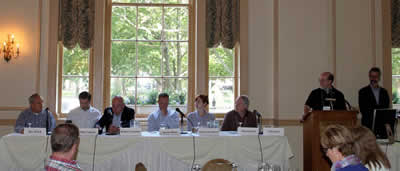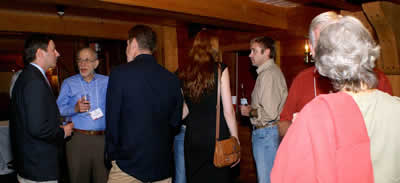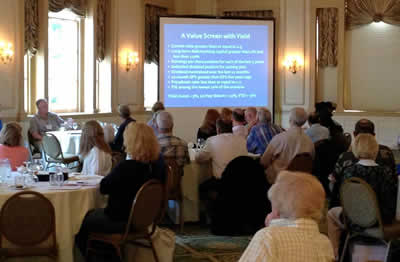 |
 |
| Cabot Editors |
From August 13 through August 16, 2013 participants in the first Cabot Investors Conference gathered in the bucolic town of Salem, MA. The assembled audience shared several common traits. All had a keen interest in investing and in learning about the world of equities, ETFS and options, etc. along with the tools of the trade, such as charting. The men and women who signed up for the meetings are subscribers to Cabot Investing Newsletters. They were motivated to travel to Salem for an opportunity to interact in a more personal environment with the editors that they were acquainted with through phone conversations, on-line videos and digital or print publications. People came to New England from all over the United States; Alaska; Calgary, Canada; and Shuttgard, Germany.
On the first evening we were treated to a spirited cocktail party. Everyone had a name tag that included the city in which they reside. Pasted on the tags were a series of colored dots. It was not difficult to figure out that each dot represented one of the newsletters to which guests subscribe. Most of those present manage their own money, but a few were professionals who are employed as money managers. Even financial advisors are in need of solid advice.
Cabot has an interesting history. It was started by Carlton Lutts Jr. in 1970. Although Lutts worked as an engineer for General Electric, his real passion was investing. His eldest son, Tim, now president of the company, said that his father wanted to help people so he began to write and publish Cabot Market Letter from home. In it he offered his ideas on stock selection and market timing. The year was a propitious one as stocks were rising. Arranging a conference was actually Tim’s idea. He spoke to his father about it 25 years ago, but a quarter of a century passed until the younger Mr. Lutts was able to implement the idea.
Before we advance further with regards to reporting about the conference, we’d like to introduce you, our readers, to Cabot’s website: http://www.cabot.net. It provides valuable information about the organization, which illustrates why the company has 250,000 subscribers. We discovered Cabot through Mark Hulbert who for the past 30 years has anonymously purchased a plethora of advisory services that he reviews and ranks. His byline also appears in the business section of the Sunday New York Times and in the Wall Street Journal. Hulbert has consistently given Cabot high marks.
 |
| Cocktail Party |
The company employs a staff of 20. The friendly attitude and exemplary service towards their clientele is evident whether you contact them by email or phone. During this special face-to-face opportunity their interest in their customers also manifested itself at the Hawthorne Hotel, the venue where the meetings were held. Even before we arrived in Salem, we felt as though we were acquainted with the eight editors of the enterprise’s 10 publications. In this digital world Cabot is able to offer free videos hosted by alternating editors. And when you continuously read and follow someone’s opinions and recommendations you learn to recognize his or her focus. Eight of the publications were originated by Cabot personnel and two, Dick Davis Investment and Dick Davis Dividend Digests, were acquired.
The plenary session began with an introduction by Tim Lutts, who said that there is no best way to invest but that there are different systems. Therefore, whether you are a growth or value investor, like to buy ETFS, are interested in the research of outside advisors, want to use options, prefer small-caps or emerging markets, Cabot has a product that will suit your proclivities. The meetings took two forms. Some were panels. Others called breakout sessions were led by a single editor and pinpointed that person’s expertise.
During the panels you were aware of the respect that the speakers had for each other and how interested they were in the way their colleagues pursued their objectives. Although the editors had different points of view and varying specialties, all had the same goal—to help the listeners sharpen their market skills. Truth is that Cabot does the work for you. You are told what to buy, when to buy and when to sell. The letters have different publication frequencies and are always emailed after the market closes. If needed (i.e., a stock had poor earnings, plunged and should be sold) you might find an update (special hotline) in your in-box. One of our favorite Cabot offerings is published once a year in mid-December at the bargain price of $30. Written with substantial details it describes 10 low-priced stocks and why they should be purchased immediately and held short-term. In 2013 eight of the group advanced in price and one did so well, up 128%, that we added to the position.
 |
| Breakout Session |
Mike Cintolo, a growth investor, who writes the Cabot Market Letter and Top Ten Trader came to Cabot right out of college. His father subscribed to Cabot Market Letter and Mike was not shy about asking Carlton Lutts for a job. Tim Lutts, who pens Stock of the Month, and Roy Ward, whose signature is attached to Benjamin Graham Value Investor, shared the stage with Mike to discuss “Where Is the Market Heading Next.” Mike predicted that the next 13 years will be better than the past. He talked about how he uses the company’s proprietary two-second indicator, so named because it takes two seconds to calculate the number of lows on a given day. Roy said that since he seeks out undervalued companies, he buys whether the market is high or low. Tim talked about businesses like Google, Facebook, Linked In and YY whose products have brought about great changes in the world.
On that first morning there were two other 45-minute panels about identifying and using major themes and favorite investments now. Roy stressed that he looks at the 10-year history of companies and assesses their five-year earnings. He likes innovative firms that are growing and favors market caps of at least $100,000,000. He did caution that even though he searches for long-term trends, unforeseen events could occur. Paul Goodwin seemed to be in agreement, but added that drops like 1929 or 2000 happen only once in a lifetime. He sees the market grinding higher, but cautioned that there could be a September-October bottom. At the end of each session ample time was allotted for Q. and A. In the discussion about thematic elements we heard that some of them are an aging population, the genetic revolution, east-west politics and climate change. The best ideas seminar was cogent and intriguing. From the enthusiastic response it seemed as though everyone in the room might purchase every suggestion. That very afternoon a mutual fund manager being interviewed on CNBC said that his favorite stock was the same one that Roy had selected. Tom Garrity, whose specialty is small-cap investing, is a very thorough researcher. His choice, which appeared in the next issue of Small-Cap Confidential, was presented with the most in-depth analysis possible about how the company and its product function. During one of the sessions Paul offered that no one can manage your portfolio as well as you can, which is, of course, what brought all of us to this gathering.
In the afternoon there were nine topics, three each hour, from which to choose. Mike presented Chart School and it was, indeed, a very useful subject. Charts are important, but can be hard to master: stochastics, Fibonacci bands, MACDs, cups and handles and so forth. Mike simplified the reading of charts. He reported that despite his use of the complicated charts developed by IBD he often turns to the simpler StockCharts.com. Because two of us attended the conference we had the benefit of listening to and sharing the information from two out of three of each of the afternoon forums. Topics ranged from options and emerging markets, to multiple strategies and more.
On the following morning four more lectures were offered. Tim Lutts ended the conference with his presentation “It’s Time To Be An Optimist.” His thesis is that our lives are constantly improving through new inventions. He again mentioned some of the companies that have altered our well-being. One of his predictions is the coming of self-driving cars.
There were many hand-outs to take home, including one invaluable book, ” All-Weather Wisdom: Cabot Market Letter Advice through the Turbulence of 2008-2013.” Essays from prior years seem relevant today and all are worth reading.
Serious concerns had brought us to Salem, but the sojourn was a pleasurable one as well. It is a reflection of the spirit of Cabot. Once a week the staff plays games in the office. Three months before our arrival we received a detailed email from Maura Lockwood, who made many of the conference arrangements. The missive included a list of recreational activities in Salem and nearby Cambridge and Boston. The $999 fee plus $450 for spouses, friends, or partners
included the evening party, two lovely breakfasts and lunches as well a one-hour trolley tour of Salem. The quintessential New England town, it’s no wonder that Maura said, “ We love working in Salem. Some of us live here, too.”
 |
| Omni Parker House Lobby |
For a stop-over in Boston we recommend the Omni Parker Hotel, a member of the Historic Hotels of America. It is the longest continuously operating establishment in the United States accommodating overnight guests. History is written all over it. Mr. Parker’s portrait hangs in Parker’s Restaurant along with another painting of the famous swans that glide on the pond in the nearby Commons. The hostelry began life as the Parker Inn and as it expanded throughout the 150 years it has been housing travelers, it has garnered more prestige and many accolades. The handsome and commodious lobby whispers that many important visitors have passed through this elegant space. The oak-paneled walls and ceilings and stunning chandeliers recall a design of another era that is still much admired today. Our room was old-fashioned, too, but in a most comfortable way. On Saturday mornings between 10 and 11 Guest Services Manager, Seamus Murphy, guides a tour for guests and talks about the history of the hotel while walking the group through the property. The kitchen invented the famous Parker House rolls and Boston Cream Pie, two dishes that became staples in American cooking. While most of us think of scrod as the name of a fish, it actually means “catch of the day” and was coined at Parker’s Restaurant. The site of the Omni Parker Hotel is one of the best in Boston. In addition to being close to the Commons and located along the Freedom Trail; Beacon Hill, Faneuil Hall and many of the other attractions that bring tourists to the city are nearby.
Omni Parker House, 60 School St., Boston MA 02108, Tel. 617-227-8600. http://www.omnihotels.com/parkerhouse
Summer, 2013
|
 |







